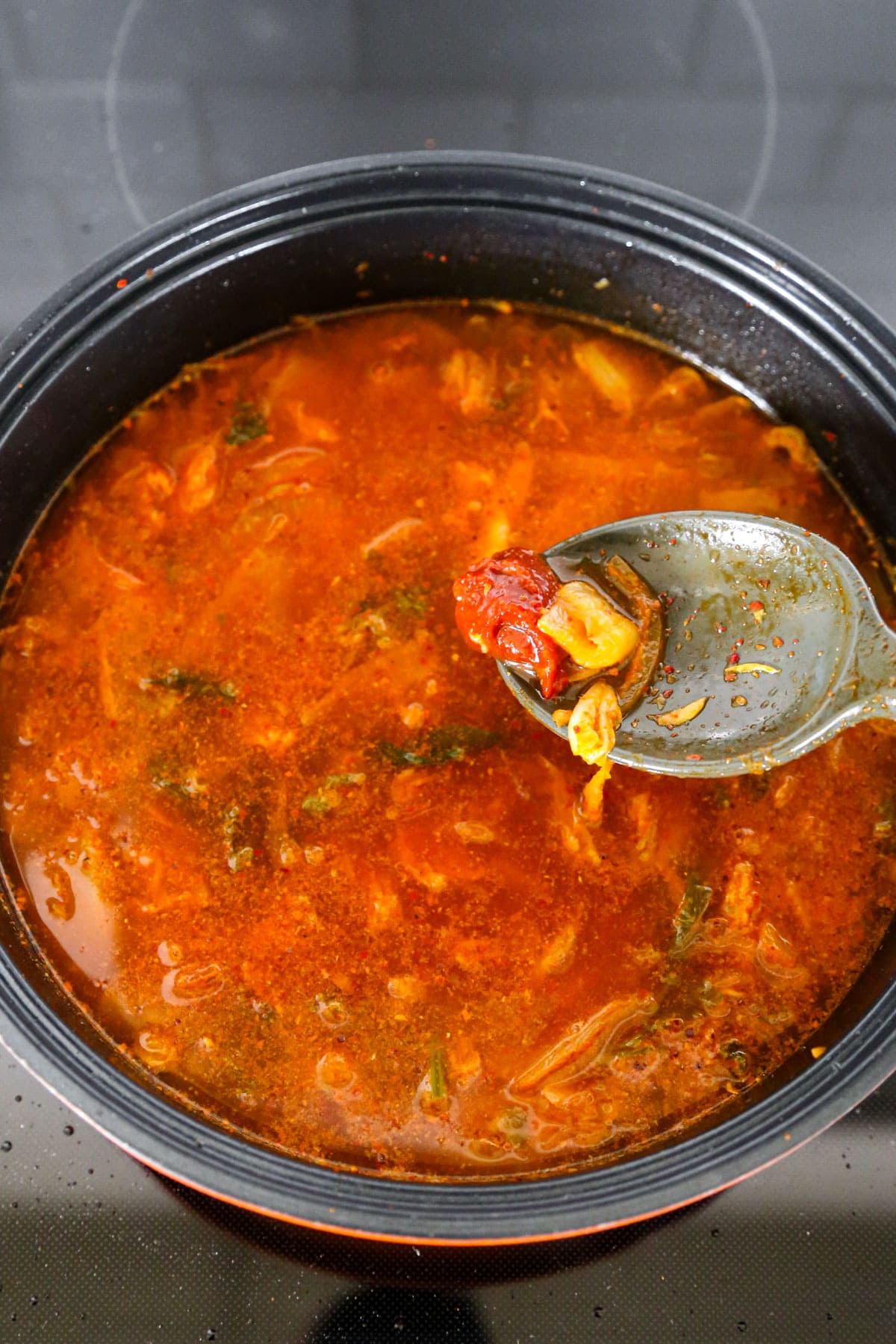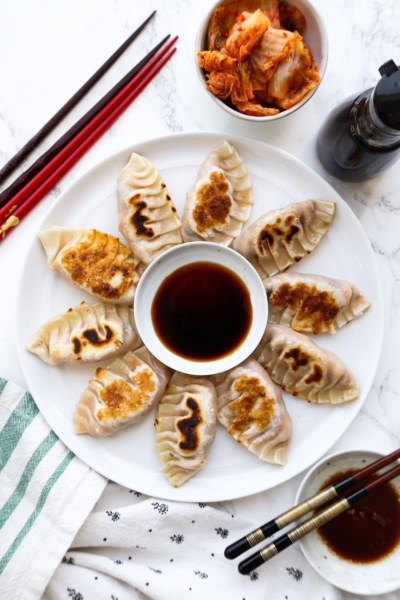35 minutes is all you need to make this comforting kimchi jjigae. With its salty, savory, and smoky flavors, this classic Korean kimchi stew can be served as a main with a side of rice, or as part of a family style meal. This recipe is meat-free (vegetarian) and can be also be made 100% vegan.

Making a big pot of stew is one of the easiest ways to serve dinner because little prepping is involved. It’s relatively mess-free as it only requires a cutting board, a chef’s knife, a large pot, and a ladle, and there is plenty left to enjoy as a meal for the next day or two.
It’s also an easy way to eat healthier, especially if the stew contains little to no meat. For this recipe I have omitted all meats and am only using tofu as the main protein. But feel free to add another protein if you are looking for a dish that’s more filling and hearty. Keep reading to find out how you can alter this recipe to your liking.
Table of contents

What is Kimchi Jjigae?
Kimchi jjigae is a popular Korean stew made with kimchi, tofu, vegetables, and often pork belly or pork shoulder. In order to infuse the dish with more concentrated flavors, a more fermented kimchi (one that has aged for longer) is used to make the stew. The kimchi provides a pungent, tangy, and spicy flavor, while the other ingredients add depth and richness to the stew.
It’s a comforting dish enjoyed year-round but especially cherished during colder months. Kimchi jjigae is often served piping hot, straight from the pot – usually a stone pot – and is commonly enjoyed with a bowl of steamed rice.

Kimchi Jjigae Ingredients
- Kimchi and kimchi juice: Choosing the right kimchi for this dish is essential for the overall taste of the dish. I don’t recommend buying fresh kimchi as it tends to have a watered down, almost sweet flavor. You will need napa cabbage kimchi that is very concentrated in flavor, which means that it had time to ferment and develop pungent and sour flavors (some of them are even fizzy). Some of my favorite brands are Pulmuone, Jongga, and Akiyama.
- Onion: A small regular onion that’s finely sliced adds a little sweetness to the stew.
- Garlic: Adding a couple of garlic cloves gives the broth some nuttiness and a pungent taste unique to garlic.
- Gochugaru: These Korean red chili flakes aren’t so much as spicy as they are smoky, and they give the dish a vibrant red color.
- Gochujang: Gochujang is a Korean fermented red chili paste that’s spicy, funky, peppery, and a little sweet.
- Soy sauce: A splash of soy sauce is added to bring out the umami and earthiness of kimchi jjigae.
- Tofu: Firm tofu is used as the main protein for this stew. The firm texture is preferred over the silken type for this dish to prevent the tofu from falling apart and getting lost in the broth.
- Green onions: As with most Asian recipes, green onions are included as a topping to give the dish a refreshing crunch and a little sweetness.


How To Make Kimchi Jjigae
- Prep and gather all of your ingredients.
- Fry the kimchi, onion, and garlic with a little oil, in a pot over medium high heat. This is to remove some of the water from the kimchi, thus, making the flavors more concentrated.
- Add the water, kimchi juice, gochugaru, gochujang, and soy sauce to the pot, and bring the soup to a boil.
- Add the tofu and bring the pot to a boil one more time.
- Lower the heat and cover the pot with a lid. Simmer for 15 minutes.
- Serve the kimchi jjigae topped with chopped green onions and a side of rice.
Cooking Tips
- If you would like to add another protein such as pork, beef, chicken, or shrimp, add it after cooking the kimchi and before pouring the liquid. Cook for a few minutes until the protein is cooked through, and follow the recipe the same way.
- For a more pungent and salty taste, add a splash of fish sauce.
- For a more filling and unique meal, add one serving (about 3 ounces) of fresh ramen noodles, and 1/2 cup of shredded cheese, such as mozzarella.
- Vegan. To make this recipe vegan, choose a vegan kimchi such as Choi’s Kimchi Company. Or, make it from scratch using my vegan kimchi recipe.

Storage
Fridge: Let the kimchi jjigae cool to room temperature. Transfer it to an airtight storage container and refrigerate for up to 4 days.
Freezer: You can freeze kimchi jjigae but it’s best to do it without the tofu as the texture will change and become unpleasant. The best way to do this is to take out the tofu and let the stew cool down to room temperature. Divide it into individual servings – I like to use to storage bags but you can also use airtight storage containers – and freeze for up to 2 months. Add fresh tofu when reheating the stew.
Frequently Asked Questions
It may or may not be. If the stew contains soy sauce, such as this one, it will not be gluten-free. However, swapping regular soy sauce for tamari sauce or liquid aminos will make it gluten-free. It’s also important to note that some kimchi may contain gluten if it was made using flour, fish sauce, and/or soy sauce. Always check the list of ingredients before buying kimchi if you have a gluten sensitivity.
Kimchi jjigae is a simple tofu stew made with firm tofu and a little pork. Tofu stew, called soondubu, is more delicate and is made using silken tofu and mixed seafood. The result is a tofu stew that’s more seafood forward in taste, while kimchi jjigae is more salty and sour.
Kimchi jjigae is both low in fat and calories. Tofu (make sure it’s organic) is high in protein, rich in nutrients, and excellent for bone health. Kimchi is packed with probiotics excellent for gut health and to combat inflammation. The only downside to this dish is that it can be high in sodium, which is not a good option for those suffering from high blood pressure or certain heart conditions.

What To Eat With Kimchi Jjigae
A bowl of warm rice is usually served with this classic Korean kimchi stew, along with some banchan (Korean side dishes), and grilled meats such as this chicken bulgogi.
Banchan
- Korean bean sprout salad (sookju namul)
- Spicy daikon radish salad (musaengchae)
- Korean cucumber salad (oi muchim)
- Korean chive pancakes (buchujeon)
Subscribe to my newsletter and receive the latest recipes and weekly favorites straight to your inbox. Join me on Pinterest, Facebook, and Instagram for more cooking tips and adventures!
Did you like this recipe? Are there changes you made that you would like to share? Share your tips and recommendations in the comments section below!
Print
Tofu Kimchi Jjigae
- Prep Time: 15 minutes
- Cook Time: 20 minutes
- Total Time: 35 minutes
- Yield: 4 bowls 1x
- Category: Soup
- Method: Boiling
- Cuisine: Korean
- Diet: Vegetarian
Description
35 minutes is all you need to make this comforting kimchi jjigae. With its salty, savory, and smoky flavors, this classic Korean kimchi stew can be served as a main with a side of rice, or as part of a family style meal.
Ingredients
- 1 tablespoon vegetable oil or grapeseed oil
- 2 cups kimchi, cut into bite size pieces
- 1 small onion, finely sliced
- 2 garlic cloves, minced
- 4 cups water
- 1/4 cup kimchi juice
- 2 teaspoons gochugaru
- 1 teaspoon gochujang
- 1/2 tablespoon soy sauce
- 1 block (12 to 14 ounces) firm tofu, drained and sliced into bite size pieces
- 3 green onions, finely chopped
- Salt, to taste
Instructions
- In a medium pot over medium high heat, add the oil, kimchi, onion, and garlic.
- Stir fry for 5 to 7 minutes, until the onions and kimchi have softened.
- Add the water, kimchi juice, gochugaru, gochujang and soy sauce.
- Bring the soup to a boil and add the tofu.
- Bring to a boil again and lower the heat to a bubbling simmer. Cover and cook for 15 minutes.
- Turn the heat off, add the green onions, and season with salt, if needed. Serve hot with a side of rice.
Notes
To make this soup more sour, add 1 tablespoon of plain rice vinegar.
Nutrition
- Serving Size: 1 serving
- Calories: 125
- Sugar: 2.5g
- Sodium: 485mg
- Fat: 9.1g
- Saturated Fat: 3.6g
- Unsaturated Fat: 3.4g
- Trans Fat: 0g
- Carbohydrates: 7.9g
- Fiber: 3.4g
- Protein: 11.5g
- Cholesterol: 0mg



















Questions and Reviews
Quick, easy recipe, but a bit bland. I added a bit of chicken stock (vegetable stock would work too) and that was just what it needed. Without the stock it is just boiled kimchi. Will definitely make again!